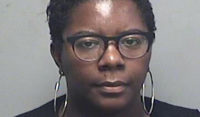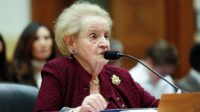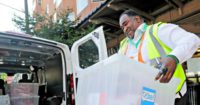Absentee / Mail-in Voting
All states have some form of absentee or mail-in voting due to federal requirements. These voters normally include military and overseas citizens, voters with disabilities and students who reside in a different state. For example, absentee or mail-in ballots are sent to these military and overseas voters 45 days prior to federal elections. However, absentee or mail-in voting is often limited by states to a number of valid excuses based on age, absentee status or an inability to vote on Election Day.
Some states have a greater number of reasons and valid excuses to vote absentee ballots by mail or in-person in an election office. A number of states have no-excuse absentee or mail voting. Lastly, a number of states have implemented an entire method of mail-in balloting that includes return of ballots to secure boxes or by postal mail. Oregon instituted an all-mail-in balloting system in 1998 and other states like Washington and Colorado have instituted similar all mail ballot methods of voting.
Mail-in and absentee balloting provides certain vulnerabilities to the electoral system:
- One stated general purpose for no-excuse absentee or mail ballot voting is to increase convenience and reduce long lines on Election Day. However, “Election Day” has become “Election Month,” which has increased the overall costs of election administration. County election offices that must process a large number of mailed ballots will experience significant delays in releasing official election results. A month or more of voting dramatically increases the overall costs to political campaigns for poll watching and get-out-the-vote efforts prior to Election Day.
- Mail-in ballots are not cast in the secure polling place where precinct poll workers can confirm addresses and verify identification. A great deal of voter fraud and abuse of absentee and mail-in ballots has been documented across the country. Absentee or mail-in balloting may spur a short-term increase in turnout in local elections; however, there is no evidence that voting by mail increases overall turnout for the long term in general elections.
- Absentee or mail-in balloting requires the use of the U.S. Postal Service (USPS) to transmit and return the ballot. This often causes delays to the election office. Citizens in states that use mail-in ballots often authorize the return of ballots to secure mail boxes that voters can use if they distrust the postal service.
A number of states authorize or require in-person absentee voting with verification by voter ID, and some states require a voter ID at the time of absentee or mail-in ballot request or return.
Alternatively, many states that allow absentee or mail-in voting use signature comparison to verify the identity of the voter. Many believe that signature verification is error-prone and not uniformly implemented by election officials across the country. While signature verification does catch a small percentage of invalid ballots or voter fraud, the system often fails to identify a great many irregularities associated with absentee or mail-in voting. Alternatively, many argue that signature verification routinely disenfranchises thousands of voters when it is used to ferret out an invalid signature.
ACRU Commentary
About That Voter-ID Fracas in Alabama: Much Ado About Nothing
By Hans A. von Spakovsky Many on the left are in a ferment over Alabama's closure of some part-time Department of Motor Vehicles offices. It's being done for budgetary reasons, but liberals are claiming it's being done to raise a "barrier for poor and minority voters" in getting an ID to vote, according to the Washington Post. Former secretary of state Hillary Clinton said that "it's a blast from the Jim Crow past" and Jesse Jackson claimed that "this new Jim Crow isn't subtle." It's really a sign of how desperate critics of voter-ID laws are that they would raise such inflammatory, ridiculous claims over a budget issue that has nothing to do with race, Jim Crow, or discrimination. After all, they've been steadily losing their fight against voter ID in the courts, with only a few exceptions, and in the realm of public opinion. Alabama's new voter-ID law for both in-person and absentee voting went into effect last year. Despite the outcries that it would "suppress" votes, there have been no problems or complaints that anyone has been unable to vote because of the new requirement. It's been the same in all of the other states, such as Georgia and Indiana, that have implemented such ID laws. I've written numerous papers looking at turnout data in states after ID laws became effective -- ID laws have no discernible effect on decreasing or preventing turnout. Alabama has 44 driver's-license offices throughout the state. It apparently also had 31 satellite offices that were open only part-time and that accounted for less than 5 percent of the driver's licenses issued each year. Because of the budget passed by the state legislature, Alabama's state government had to "allocate scarce limited resources in Fiscal Year 2016," according to a letter sent by Governor Robert Bentley to Representative Terri Sewell (D., Ala). So the state government decided to close these satellite offices. Sewell is one of the critics whose "impulsive, ill-informed" comments about that decision were, Governor Bentley says, "based on irresponsible media reports." What all of the media and critics missed or deliberately ignored is that, in addition to being able to use a driver's license to meet the voter-ID requirement, you can get a free voter ID in every single county in the state. In addition to DMV offices, the secretary of state offers free voter IDs in all 67 counties through the local election registrar.
How an Alabama Woman Used Voter Fraud to Get Her Boyfriend Elected
In Dothan, Ala., the verdict is in: it was election fraud. Last week, a jury convicted 66-year-old Olivia Reynolds on 24 felony counts of absentee ballot fraud in the contested 2013 election for the Dothan City Commission. Reynolds worked on the re-election campaign for District 2 incumbent Amos Newsome. During the tainted 2013 election, she forged and altered enough absentee ballots to guarantee victory for her boss and boyfriend. The verdict will only come as a shock to those who still insist that voter fraud simply doesn't exist in the U.S. In 2013, Newsome narrowly won reelection to his office, besting challenger Lamesa Danzey by a scant 14 votes. However, after Danzey identified at least 37 absentee ballots that she claimed were illegally cast, the Houston County Sheriff began investigating irregularities in the District 2 race. Danzey, it turned out, had won the in-person vote by a hundred votes, 343-243. But Newsome had carried a whopping 96% of the absentee vote, winning 119 of the 124 ballots cast by mail. That was enough to tip the scales in the incumbent's favor - and to raise the eyebrows of investigators given how much the margin of absentee ballots cast for Newsome differed from the margin of votes cast for him on Election Day. Interestingly, this was not the first time Newsome had lost the in-person vote but carried the absentee vote by wide margins. In 2011, he lost at the polls by 45 votes, yet won 131 absentee ballots - all but 9 cast that year. The Sheriff's investigation culminated in the arrest of Reynolds and three others. Three of the four have now been convicted in what appears to have been an organized conspiracy to deny the citizens of Dothan their right to free and fair elections. Investigators found that the defendants had fraudulently applied for and submitted absentee ballots for registered voters. During Reynolds' trial, it was revealed that she went even further. Witnesses testified that she ordered them to vote for Newsome. Four witnesses confirmed they had done so even though they intended to vote against him. In some cases, Reynolds illegally filled out part or all of voters' ballots for them. In the course of the trial, some voters discovered their ballots had evidently been cast for Newsome, even though they had never voted for him. Alabama law requires that absentee votes must be observed by two witnesses, to safeguard against fraud. But the case reveals how easy it is to circumvent that requirement - and just how insecure absentee ballots are. In fact, absentee ballot fraud is one of the most common forms of election fraud. Reynolds' attorney, Chris Capps, responded to the charges against his client with allegations of racism on the part of prosecutors and law enforcement. The city of Dothan, Capps said, was just out to get Newsome and undermine the ability of a minority district to vote absentee. Of course, Capps wanted jurors to overlook the fact that the primary victims of Reynolds' fraud were the minority residents of District 2 whom she effectively disenfranchised. Such false claims are sadly common in the debate over election fraud. Opponents characterize efforts to ensure the integrity of the electoral process, such as requiring photo ID for both in-person and absentee voting, as little more than an attempt to suppress minority votes. In reality, nothing of the kind is true. Often these claims, such as in this case, are merely an attempt to distract the public from the criminal activity of the defendants and to deter and scare prosecutors from proceeding. Analysis has revealed that minority turnout has actually increased in states with photo ID requirements. At trial, Assistant District Attorney Banks Smith reminded jurors and the public that voter fraud cases are not about political agendas or racially-motivated attacks. "This case is about the sanctity of the ballot." And jurors, it seems, paid attention. The evidence was so overwhelming it took less than an hour for the jury to return a guilty verdict. Reynolds is the third person convicted of absentee ballot fraud in connection with the Newsome campaign. Though Commissioner Newsome himself has not been directly fingered for criminal conduct, the legitimacy of his election has clearly been called into question.
List of Voter Fraud Cases Keeps Growing
The Heritage Foundation's list of nearly 300 documented cases of voter fraud in the United States continues to grow. Recent additions reveal that voter fraud is not just an individual or isolated crime; in some counties and communities, election fraud is almost a way of life. These additions again reinforce the need for measures such as voter ID laws and procedures designed to verify the accuracy of voter registration information are needed to prevent these crimes in the first place. Take East Chicago, Ind., for example, a town made infamous by the extensive voter fraud that occurred there in the 2003 Democratic mayoral primary election. The Daily Signal is the multimedia news organization of The Heritage Foundation. We'll respect your inbox and keep you informed. The fraud was so pervasive that the Indiana Supreme Court overturned the results of the primary and ordered a new special election that resulted in a different winner. A local judge found "direct, competent, and convincing evidence" that supporters of the election's apparent victor, incumbent Mayor Robert Pastrick, orchestrated an elaborate scheme of absentee ballot fraud.
Don’t Believe Voter Fraud Happens? Here Are More Examples
By Hans von Spakovsky In the interest of helping out the editorial writers and pundits of media outlets who don't think voter fraud occurs, I wanted to note just a few recent cases (and readers interested in seeing almost 200 more such cases can do so here.): In McAllen, Texas, two campaign workers (known as politiqueras in local parlance) who bribed voters with cocaine, beer, cigarettes and cash during a 2012 school board election have been sentenced separately to serve eight and four months in prison, respectively. U.S. District Court Judge Randy Crane called this election fraud "terrible" and said that "our country requires that our voting process be clear and free of fraud for democracy to work... it's dangerous for this to occur without consequence." A couple in Le Sueur, Minn., was charged with felony voter registration fraud for lying about where they lived so they could vote in a school bond referendum in another town. A woman in Dothan, Ala., was sentenced to six months in prison for her part in a voter fraud scheme that got a city commissioner re-elected. She was the second of the four people charged to have been found guilty of voter fraud in the case, which may have involved more than 100 absentee ballots.
How to Fraud-Proof Elections
By Edwin Meese III and Ken Blackwell Once upon a time, Americans got together on Election Day, went to the polls, and chose our leaders. Voting on the same day helped bind us together as self-governing citizens in a free republic. It even felt like a national holiday -- Independence Day without the fireworks. Except for those traveling or who are infirm and who can use absentee ballots, Election Day puts everyone in the same boat. As a civic exercise in equality, it is unparalleled. It has the added advantage of making vote fraud more difficult, since there is a very short window in which to commit it. But over the past few decades, election laws have been relaxed in the name of convenience, with "reforms" such as early voting, same-day registration, Sunday and evening voting hours, no-excuse absentee voting and allowing out-of-precinct ballots. All of these increase the possibility of vote fraud. At the same time, despite a clear mandate in the National Voter Registration Act (also known as the Motor Voter Law) to keep accurate registrations, the system has grown lax; election authorities have left millions on the voter rolls who should not be there.
Here Comes the 2014 Voter Fraud
In the past few months, a former police chief in Pennsylvania pleaded guilty to voter fraud in a town-council election. That fraud had flipped the outcome of a primary election. Former Connecticut legislator Christina Ayala has been indicted on 19 charges of voter fraud, including voting in districts where she didn't reside. (She hasn't entered a plea.) A Mississippi grand jury indicted seven individuals for voter fraud in the 2013 Hattiesburg mayoral contest, which featured voting by ineligible felons and impersonation fraud. A woman in Polk County, Tenn., was indicted on a charge of vote-buying--a practice that the local district attorney said had too long "been accepted as part of life" there. Now come the midterm elections on Nov. 4. What is the likelihood that your vote won't count? That your vote will, in effect, be canceled or stolen as a consequence of mistakes by election officials or fraudulent votes cast by campaign workers or ineligible voters like felons and noncitizens?
News
Award Winning Democrat Just Got Served With A Stack Of Felony Charges
The Democratic Party loves the “unconventional methods” of Michigan party official Sherikia Hawkins so much that they gave her an award. Her methods were so unusual that she was arrested on six felony charges. Hawkins engaged the community in voting by “forging records and falsely marking absentee ballots as invalid” during the 2018 midterm election.
USPS failures contribute to suppressing votes
The current tally of mail in votes voided by California election officials in its March primary is 102,000+. Most were rejected because they arrived too late for counting. Combine the famous inefficiency of the post office with the potential of dishonest officials keeping ballots in the bottom drawer for a day or two, and what you’ve got is stolen votes.
New York election officials skipped math class
Many important things happen immediately after elections for outgoing, newly incoming, and even incumbent officials. Time wasted counting votes means constituents are ignored and fraud gains an edge. A month after New York’s mail in primaries, winners and losers are still in limbo. New York’s nearly mail-only election is a mess and it’s not going to get better by November.
Liberals’ call for mail ballot security identifies its problems
A leftist coalition and leftist former officials are asking the federal government for “security” funds for states advocating for mail-only elections. NO! But their request does identify important points. 1. The left is admitting there’s a problem. 2. What is stopping global bad actors from mailing perfect ballot facsimiles to American addresses? China counterfeits everything else - why not ballots?
Inaccurate voter registration is an incubator for fraud
The difference between absentee voting and mail-only voting is that absentee voting requires a request for a ballot, but mail-only voting means a ballot will be sent to a house where a voter once lived. This article provides a great primer on why this is an invitation for fraud, and also uses Honest Elections Project data to show how widespread voter registration inaccuracies truly are.
Mail-only voting is a vote stealer
According to an analysis of this year's primaries by National Public Radio, at least 65,000 mail in votes were not counted in 17 states studied. Uncounted mail-only ballots, even without malfeasance by dishonest election activists, are a way to stifle American’s political voices. Many elections have been determined by a handful of votes. 65,000 is a big handful.






